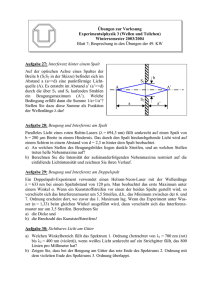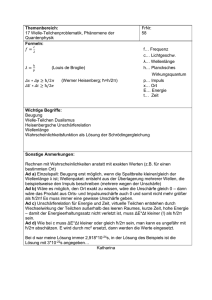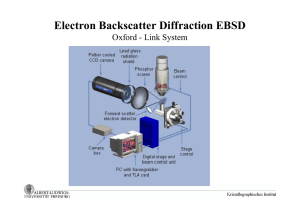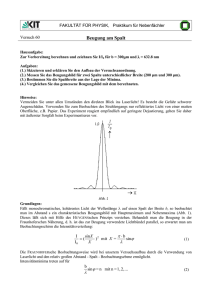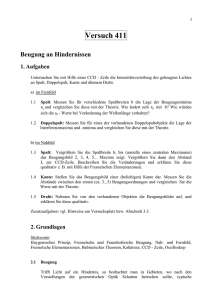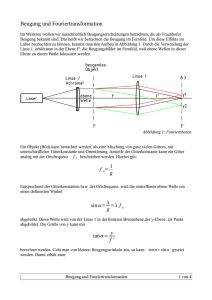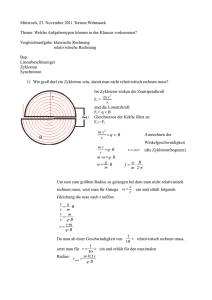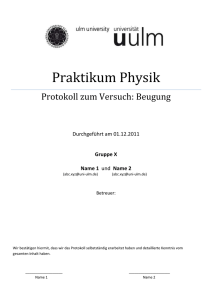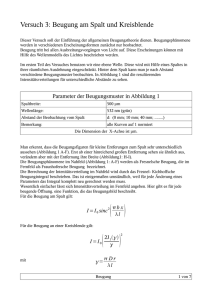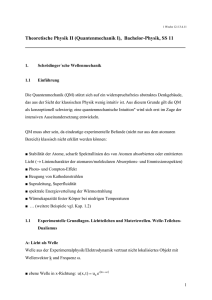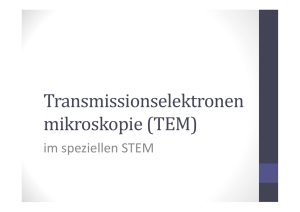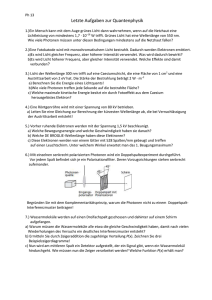PowerPoint-Folien zum Vortrag
Werbung
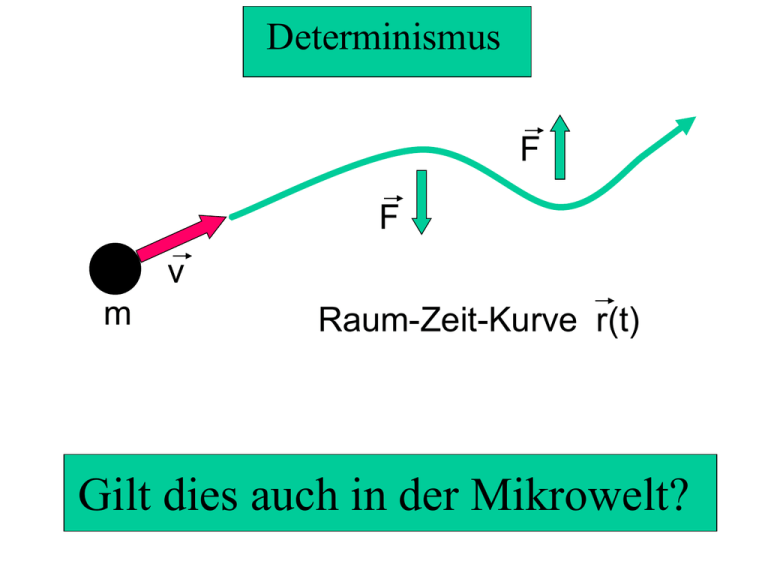
Determinismus F F v m Raum-Zeit-Kurve r(t) Gilt dies auch in der Mikrowelt? Elektron Als erstes Elementar-Teilchen entdeckt von J.J. Thomson 1897: Ruhemasse m0= 9.1094 10-31kg Elementarladung e = 1.6022 10-19C Atom der Ordnungszahl Z Kern Z+ Elektronenhülle Z - Metall - Kristall 0.2nm + AustrittsArbeit T, E Kathode Anode - + Ua Elektronenstrahl Ekin = e Ua Fokussierung eines Elektronenstrahls Quelle Linse Objekt Ablenkung eines Elektronenstrahls Quelle Linse - Objekt + Ablenker Eigenschaften des Elektronenstrahls • Trägheitslose Ablenkbarkeit • Feinste Fokussierbarkeit • Höchste Energiedichte Elektronenstrahl cm2 10-7 Watt/cm2 109 Lichtbogen Schweißbrenner 10-3 10-2 105 104 Elektronenstrahl – Bohren und Fräsen + Bohrungsdurchmesser 4/1000 mm Elektronenstrahl-Schweißen - + A B Elektronenstrahl-Schweißen - + A B Electron beam vs. TIG Komplizierte Schweissnähte Gasgenerator für Airbag Photo: Messer-Griesheim Electron Beam Lithography - + resist silicon 0.0001 mm ENIAC 1944 Electronic Numeric Integrator and Calculator Höchstintegration 10mm, 106 Komp .................................heute: Strukturbreiten < 1/10,000mm Elektronen sind Teilchen ! • Masse m • Ladung e • kinetische Energie e Ua • lokalisierbar • elektromagn. Kräfte • Bahnen Newton Mechanik Materiewellen h h p mv Wellenlänge Impuls „Wer sich über die Quantenmechanik nicht wundert, der hat sie nicht verstanden !“ Louis Victor Pierre Raymond Prince de Broglie, 1892 - 1987 Teilchen und Wellen F Bahn: lokalisierbar F m v Raum-Zeit-Kurve r(t) ???? Welle: nicht-lokalisierbar Beugung Interferenz h /(mv) Teilchen am Spalt Welle am Spalt falsch ! Wellen: Beugung am Spalt Wellen: Beugung am Spalt Beugung am Spalt Beugung am Spalt Zweistrahl-Interferenz durch Beugung am Doppelspalt Fresnel biprism for light source biprism detector 1/q interference pattern I(x)=2I0(1+cos (2qx)) with spatial frequency q:=/ Wellen und Teilchen: Beugung am Spalt Teilchen: Beugung am Spalt p Teilchen: Beugung am Spalt x p Werner Heisenberg Heisenbergsche Unschärfe für QM-Teilchen • x p h Ort-Impuls • E t h Energie-Zeit Electron Diffraction Experiment Electron Micrograph of the slits Electron Diffraction One Slit Two Slits from: Jönsson, Z. f. Physik 161 (1961), 454 - 474 Möllenstedt, Physica B 151 (1988) 201 - 205 Möllenstedt electron biprism electron source biprism + detector 1/qc interference pattern I(x)=2I0(1+cos (2qcx)) with spatial frequency q:=/ ; ~Ubp Electron Interferometer (1962) Quantum Noise time of flight 1µs << time between impacts 1ms single electron interference Elektronenwellen = Wahrscheinlichkeitswellen de Broglie Letter to Möllenstedt Paris, 19 June 1956 Monsieur and dear Colleague, I was extremely pleased to receive your kind letter and to learn of your beautiful experiments in which you have obtained electron interference by a method analogous to Fresnel's biprism. It was, of course, a great pleasure to see that you have obtained a new and particularly brilliant proof of the formula l = h/(mv), and I shall not fail to make known your experiments to my students. Thanking you most gratefully for your communication, I beg you to accept, Monsieur and dear colleague, the expression of my devoted sentiments, Louis de Broglie Surely, you are joking Mr. Feynman We choose to examine a phenomenon which is impossible, absolutely impossible to explain in any classical way. In reality, it contains the only mystery. We should say right away that you should not try to set up this experiment. This experiment has never been done before. The trouble is that the apparatus would have to be made on an impossibly small scale ... We cannot make the mystery go away by explaining how it works. We will just tell you how it works. We are doing a thought experiment. (The Feynman Lectures on Physics) Beating of electron waves E E V t E E+E E / h Hubert Schmid, PhD thesis, Tuebingen 1985 Which Way? E E =E/h energy spectrometer • interference contrast <1 h/E • energy resolution E >h >h/E < either interference or which way entweder – oder ......... Elektronen sind Wellen • Elektronen, die interferieren, sind nicht unterscheidbar • Elektronen, die unterscheidbar sind, zeigen keine Interferenzerscheinung Elektronen sind Teilchen Zeiss Lightmicroscopes Robert Koch's Microscope (1880) Lightmicroscope ( 1960) Abbe limit of microscopy Objects < /2 do not affect the wave resolution > /2 Electron Waves HL Velocityof Electron W ave 1 non-relativistic 0.8 relativistic v c 0.6 0.4 0.2 0 200 400 @ D 600 UA kV 800 1000 1200 1000 1200 WaveLength of Electron Wave La m b d a p m @ D 10 8 6 4 non-relativistic 2 relativistic 0 200 400 @ D 600 UA kV 800 Philips CM20FEG (S)TEM Interferogram of MgO-Crystal Negatively Stained Bacteriophages Dopant Profiles in a FET amplitude diploma thesis Andreas Lenk, Dresden 2001 phase Hologram of Si [110] Hologram Parameters: UF = 600 V sF = 0.054 nm Cooperation: Prof. David Smith, ASU, Tempe, U.S.A. Co-Phthalocyanine Ugeda et al. 1978; UA = 500 kV Au – Atome in Au-Clustern Silicon in (100)-orientation 0.543 nm GaAs GaAs amplitude GaAs GaAs GaAs GaAs phase GaAs in (110)-orientation Materiewellen h h p mv Wellenlänge Impuls „Wer sich über die Quantenmechanik nicht wundert, der hat sie nicht verstanden !“ Louis Victor Pierre Raymond Prince de Broglie, 1892 - 1987
